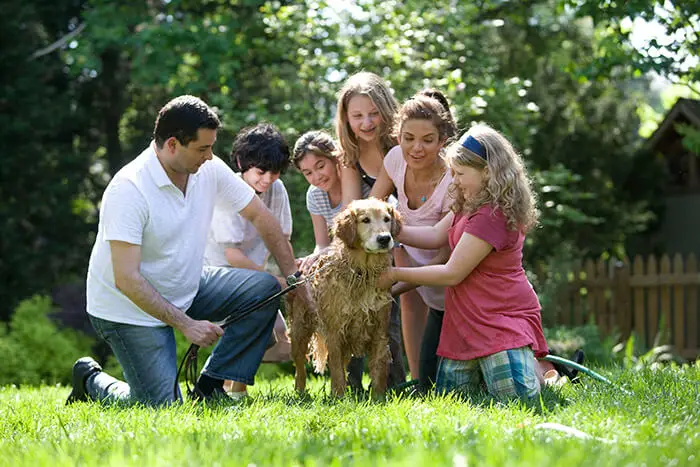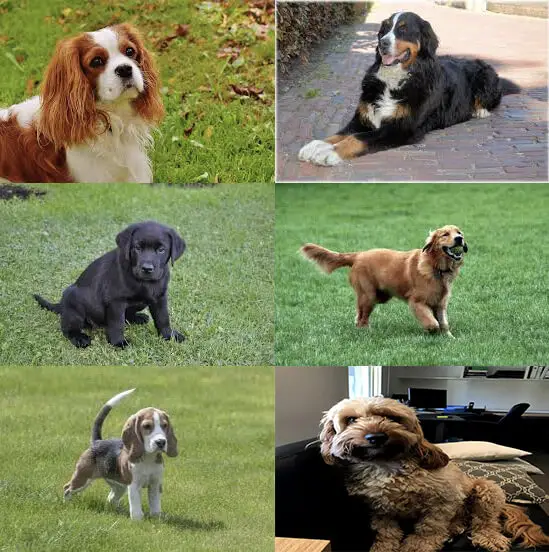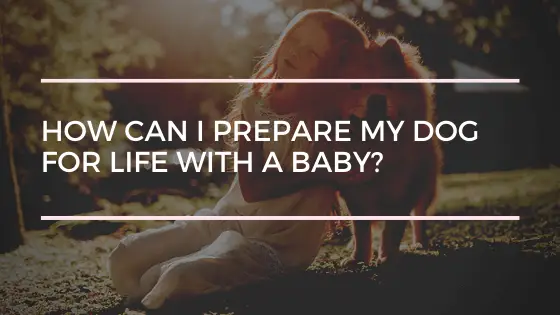Affiliate Disclosure – This post may contain affiliate links where we may receive compensation if you purchase products linked below. As an Amazon Associate, I can earn from qualifying purchases. This doesn’t cost you anything and helps keep our little blog running. Read our privacy policy for further information.
Before we welcomed our twin boys to the world, we were proud parents of our fur baby, Basil the spoodle. By the time the boys came, Basil was around 3 years old and had begun to mature as a dog but adjusting to two babies was a big change for him. Especially after being spoilt rotten for the last 3 years!

We’ve created this post to help you with some general tips to transitioning your dog from a life of receiving all the attention in the world to one where it’s suddenly shared between a baby (or babies in our case!).
The post is split into two sections planning your dog for before the baby comes and another section on living with your dog after the baby comes.
Before the Baby (or Babies) Come
Fortunately there’s lots of things you can do to get your dog ready for life with a new member to the family. Some of these we didn’t follow ourselves and are more learnings that we wish we did. Let’s get started with some of our tips of things we’d consider about your dog before your have kids.
Look at Training your Dog
Before we had the boys, we made an effort to train our dog with some pretty basic commands like sit, stay and other commands. We’re so glad we did as it made having him around the boys so much easier. Having him know when to ease off and stay away from the boys when they were practicing tummy time made us a lot less nervous!
Know your Dog’s Comfort Levels
As someone who’s owned a few dogs over my life, I’ve come to appreciate that some dogs have different limits to others on where they can be touched. There’s a few areas where it’s recommended not to touch your dog which this helpful infographic explains.
While we’re not recommending to ever let your child have free reign over touching your dog, it’s important for you to know where the limits are with your dog. We think this is important as say your dog doesn’t like their tail or ears being touched, you can begin to teach your child not to touch those areas earlier on to avoid any awkward moments where your dog is touched where they’d prefer not to be.
Begin Sensitising your Dog to your Babies Things
In readiness for your babies pending arrival we recommend getting them used to some of your babies belongings. Whether that be:
- Practicing walking by a stroller. While you might feel a bit strange walking around the streets with a stroller and no baby in it, this is a great way to adjust your dog to walking with a stroller. Trust us, when you venture out of the house the first time with your baby, the last thing on your mind will be stressing about how your dog is walking. We’d recommend getting out before the baby is due for a few test runs.
- Sniffing the cot and other baby related things in the house. Rather than just unleash everything when the baby arrives home, why not let your dog have a good sniff of everything prior to the baby coming so the novelty value of new things in the house has worn off by the time you get home for the first time with your baby.
- Your husband bringing home something from the hospital with your babies scent. While this is more after the baby comes (not before) we recommend giving your husband a towel or cloth that your baby has come into contact with while they are in hospital and taking it home for your husband to let your dog smell.
Create a Safe Spot for your Dog
Before welcoming your baby to your home, it’s important to create safe spots in your house for your dog where they can retreat to when they’ve had enough of being around the baby. Don’t forget that dogs sleep for 12-14 hours per day at a minimum so it’s important not to interrupt that. For us, we placed a dog bed in our study which can’t be accessed by our boys. Often our dog will go to our study when he’s had enough.
After the Baby (or Babies) Come
Bringing your newborn home for the first time can be a scary moment as you suddenly leave hospital and you’re all on your own. But this is also an exciting time especially as you begin the process of introducing your dog to your baby. We’ve created this list of tips of things we’d recommend you try once you’re home with your newborn.
Remember Introducing your Dog to your Baby is a Gradual Thing
While some dogs may naturally warm to babies faster than others, we recommend taking things slow and making it a gradual process. While our dog tolerated the boys when they were babies, it wasn’t until they were around 1 that he begun to properly warm to them and let them touch him. There’s a few things we found effective at helping build a relationship:
- Getting him involved in activities we partake with the boys. Whether this be going out for walks or singing with the boys inside, we’ll always make an effort to involve him in activities and not feel isolated from things.
- Let them have a sniff. From time to time it doesn’t hurt to let your dog have a sniff of your babies things to help make things familiar for them.
- Show affection to your dog in front of your baby. This is important as it both reinforces to your baby how they should treat dogs while also makes your dog associate time spent with your baby in a positive way.
- Consider using a leash in the early days. It’s expected that your dog will be excited to see your baby as they may be excited or protective. For this reason we recommend having your dog on a leash to keep them under control until they’re at a point where you’re comfortable off leash.
Catch Early Warning Signs
As you bring your newborn home, it’s possible that your dog might react with jealousy. There’s a few things we recommend looking out for which are early signs of jealousy and aggression. These include:
- Biting, pawing and growling
- Withdrawn and not interested in food
- Pinned back ears, raised ears and downward pointing tail.
If you’re seeing some of these signs, we’d recommend having your dog on a leash around your baby and slowing down the introductory process of desensitising your dog to your baby.
Create an Exercise Routine and Stick to it
Try create an exercise routine for your dog and stick to it. Whether it be for 20 minutes or an hour a day, it’s a great way of getting them out of the house for some exercise and a sniff while helping avoid the build up of cabin fever from being inside too much.
Continue to Acknowledge Your Dog
When your dog is in the same room as your baby, it’s important to acknowledge them and provide positive reinforcement to them. As we mentioned earlier in the post, your baby will see you positively interacting with your dog which will begin to set the foundation of them treating dogs like you do with positivity. While it also makes your dog associate being in the same room as your baby as a positive environment where they feel included.
Create Boundaries
While it’s important for your baby to have a sniff of your babies belongings and be involved, it’s also important to set boundaries so your dog knows what they can and can’t do. For example, we’ve always (and understandably) ensured our dog does not get close if we’re changing nappies on the floor. The same applies for the nappy bin which is also off limits.
Always Be in the Same Room As your Dog and Baby
Never leave your baby alone with your dog. Period.
Dogs have been known to carry babies like a female dog would with their puppies by carrying them with their mouth. Or worse, some dogs have been known to hurt babies as if they are prey.
Keep up the 1:1 Time
We found it hard to spend quality 1:1 time with our dog when the boys were awake so always set aside some time with him after they went to sleep for some quality 1:1 time. This included throwing a ball around in the backyard, going for a walk or even just lots of hugs and pats.
Prepare for Touching
As your baby gets older they’ll begin to be more intrigued by your dog and want to begin touching them. Most likely their tail and other areas that your dog would prefer they don’t touch. We generally recommend seating your child on your lap and holding their hand to pat your dog. Be careful they don’t pinch or try grab your dogs hair.
Plan Trips for your Dog to Socialise
We’re fortunate that our family have dogs too so we often planned little trips for our dog to go play with their dogs. If you don’t have family that have dogs perhaps even friends that have dogs would let your dog come over for a play with their dogs?
If you don’t have friends or family with dogs but looking for a way to get your dog socialising with other dogs, it might even be worth considering paid dog walking businesses in your area. Generally these businesses arrange walking of your dog with other dogs so it’s a great way for them to get out and exercise with other dogs.
What Types of Dog Breeds are Best for Children?
When it comes to deciding on a dog for young children, there’s a few different things to consider:
- Size – With big dogs you run the risk of them unintentionally knocking over your little one. While on the opposite end of the scale, some little dogs like chihuahua’s can be particularly fragile and easily injured by children if they play too rough. For this reason, try to opt for a small to medium sized dog like a Cavalier King Charles Spaniel.
- Temperament – Different dogs come with different temperaments whether that’s a spoodle with their high intelligence or a beagle with their borderline obsession with following a scent. For this reason, do your research into your dog breed to make sure it’s right for you.
- Know their Background – While we’re big fans of rescue dogs, if you do decide to go down the path of rescuing a dog, we’d recommend asking the question to what their background was like before they were rescued. These dogs are beautiful and can sometimes need additional care if they’ve come from a difficult background.

But what type of dog breeds are known for being good with children? Good question. Here’s 6 breeds of dogs that we’d recommend with a short spill about the type of dog:
- Cavalier King Charles Spaniel – Super friendly dogs characterised by their silky soft fur.
- Golden Retriever – Basically the renowned family dog, golden retrievers are a great choice for anyone looking for a dog that loves to play fetch while being a great companion for your whole family.
- Beagle – Beagles love attention but give everything plus more back in return. They love companionship and are a great breed for any young family.
- Spoodle – Closing out with the breed of our dog – a spaniel poodle! The perfect mix of a poodle (intelligence) and spaniel (companion). We love our Basil the spoodle and wouldn’t change him.

Cavalier King Charles Spaniel
Bernese Mountain Dog
Labrador Retriever
Golden Retriever
Beagle
Spoodle
While the above list is far from definitive, it should provide a good starting point in your hunt for finding a breed suitable for your dog. Don’t forget to consider size, temperament and background when considering dog breeds.
Closing
We hope this article on how to prepare your dog for life with a baby has been helpful. If you’re reading this article and don’t yet have a dog but thinking of getting one before you have kids, we couldn’t recommend this more highly. Having a dog when you’ve got a young family is plenty of fun and a great way to teach your kids respect for animals.
Affiliate Disclosure – This post may contain affiliate links where we may receive compensation if you purchase products linked below. As an Amazon Associate, I can earn from qualifying purchases. This doesn’t cost you anything and helps keep our little blog running. Read our privacy policy for further information.

My name’s Alex and I’m a husband, dad to beautiful identical twin boys, cyclist, photographer and connoisseur of great coffee!
Help I’m Having Twins has been created for me to share what I found useful as a new parent and dad to twins.


